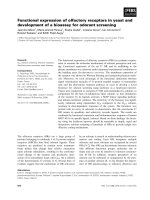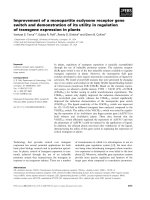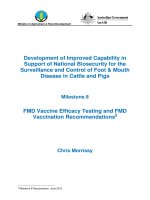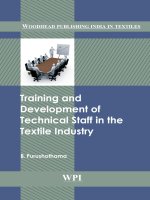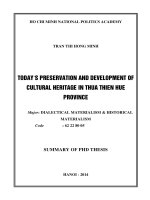Conservation and development of medicinal plants in xuan son national park phu tho province
Bạn đang xem bản rút gọn của tài liệu. Xem và tải ngay bản đầy đủ của tài liệu tại đây (2.88 MB, 51 trang )
VIETNAM NATIONAL UNIVERSITY OF FORESTRY
FACULTY OF FOREST RESOURCES AND ENVIRONMENT MANAGEMENT
STUDENT THESIS
CONSERVATION AND DEVELOPMENT OF MEDICINAL PLANTS IN
XUAN SON NATIONAL PARK, PHU THO PROVINCE
Major: Advanced Curriculum in Natural Resources Management
Code: D850101
Faculty: Forest Resources & Environmental Management
Student: Nguyen Kim Anh
Student ID: 1453090611
Class: K59B - Natural Resources Management
Course: 2014 – 2018
Advanced Education Program
Developed in Collaboration with Colorado State University, USA
Supervisor: Assoc.Prof. Dr. Hoang Van Sam
Ha Noi, September 2017
ACKNOWLEDMENTS
To complete the final thesis, firstly, I would like to express my sincere gratitude to my
supervisor Assoc.Prof. Dr. Hoang Van Sam for the continuous support of my thesis, for his
patience, motivation, and immense knowledge. His guidance helped me in all the time of
research and writing of this thesis. I could not have imagined having a better advisor and mentor
for my final thesis. Thanks to cooperating between Vietnam Forestry University and Colorado
State University, I have a chance to approach a reservoir of international knowledge and
experience.
I would like to thank all staffs of Xuan Son National Park, Forest protection and
management station of Xuan Son, local people for creating all favorable conditions and
supplying all information and data in the process of studying this dissertation.
Last but not least, this thesis could have never been completed without the support of
my friends and parents because of their encouragement and giving me the favorable conditions
during the entire process of doing research and going field works for having my work done.
Because my knowledge is limited, this thesis may have some mistakes; I would like to
receive the comments from the teachers to help my thesis becoming more complete.
Hanoi, 1st October, 2018
Student
Nguyen Kim Anh
ii
TABLE OF CONTENTS
TABLE OF CONTENTS ..................................................................................... iii
LIST OF TABLES ................................................................................................ v
LIST OF FIGURES .............................................................................................. vi
CHAPTER 1: INTRODUCTION ......................................................................... 1
CHAPTER 2: GOAL AND METHODOLOGY .................................................. 3
2.1. Goal of the study ........................................................................................ 3
2.2. Specific objectives...................................................................................... 3
2.2. Subjects – scope ......................................................................................... 3
2.3. Materials ..................................................................................................... 3
2.4. Field Investigation method ......................................................................... 4
2.4.1. Transect lines....................................................................................... 4
2.4.2. Non-field investigation methods ......................................................... 6
2.5. Data analysis .............................................................................................. 6
2.6. Proposing measures to manage and conserve medicinal plants ................ 7
CHAPTER 3: NATURAL AND SOCIAL CONDITIONS.................................. 8
3.1. Geographic location and natural conditions............................................... 8
3.1.1. Geographical location ......................................................................... 8
3.1.2. Terrain ................................................................................................. 8
3.1.3. Geology ............................................................................................... 9
3.1.4. Soil ...................................................................................................... 9
3.1.5. Climate and hydrology ........................................................................ 9
3.2. Forest status and land use ......................................................................... 10
3.2.1. The area of land types, forest types................................................... 10
3.2.2. Vegetation, animals and distribution of rare species ........................ 11
3.3. Socio - economic characteristics .............................................................. 13
3.4. Situation of socio-economic development ............................................... 14
3.4.1. Crop ................................................................................................... 14
3.4.2. Commercial service activities ........................................................... 14
3.4.3. Income of the people ......................................................................... 15
iii
3.5. Traffic ....................................................................................................... 15
3.6. Medical ..................................................................................................... 15
3.7. Education .................................................................................................. 15
CHAPTER 4: RESULT AND DISCUSSION .................................................... 16
4.1. The current status of resources and use of some medicinal plants in Xuan
Son National Park, Tan Son district, Phu Tho province ................................. 16
4.1.1. Current situation of medicinal plants in Xuan Son National Park .... 16
4.1.2. The status of using medicinal plant resources .................................. 19
4.1.3. The variety of parts used ................................................................... 19
4.1.4. Diversity of number of parts and use of medicinal plants. ............... 20
4.2. Situation of exploiting, preserving and developing medicinal plant
resources in Xuan Son National Park ............................................................. 23
4.2.1. Exploitation status ............................................................................. 23
4.2.2. Current status of conservation and development of medicinal plant
resources ...................................................................................................... 24
4.3. Research on the ecological characteristics of rare medical plants in Xuan
Son national park ............................................................................................. 27
4.3.1. Anoectochilus setaceus Blume .......................................................... 27
4.3.2. Paris polyphylla Smith ...................................................................... 29
4.3.3. Aspidistra xuansonensis var. xuansonensis ...................................... 31
4.4. Solutions for conservation and development of some precious medical
plants in Xuan Son national park .................................................................... 32
4.4.1. Threats to medicinal plant resources in Xuan Son National Park: ... 32
4.4.2. Proposed solutions to conserve medicinal plants in Xuan Son National
Park:............................................................................................................. 33
CHAPTER 5: CONCLUSION AND RECOMMeNDATION ........................... 35
5.1. Conclusion ................................................................................................ 35
5.2. Recommendation...................................................................................... 35
REFERENCES .................................................................................................... 37
APPENDICES ..................................................................................................... 38
iv
LIST OF TABLES
Table 2.1: Survey on species statistics by transect line ........................................ 5
Table 2.2: Form of information on medicinal plants by interview local people .. 6
Table 3.1: Forest and land status of Xuan Son commune ................................... 10
Table 3.2: Forest composition of Xuan Son Commune ...................................... 13
Table 4.1: Current situation of medicinal plants in Xuan Son National Park .... 16
Table 4.2: Statistics of medicinal plant components in live form ...................... 18
Table 4.3: The variety of parts used in medicine ................................................ 19
Table 4.4: Synthesis of parts used as drugs ........................................................ 21
Table 4.5: Usage of medicinal plants .................................................................. 22
Table 4.6: Market statistics and status of some herbs available in Xuan Son
National Park (time of investigation in June 2018) ............................................ 23
Table 4.7: List of medicinal plants that studied ecological characteristics in the
study site .............................................................................................................. 27
v
LIST OF FIGURES
Figure 2.1: Location of Xuan Son National Park.................................................. 3
Figure 2.2: Transect lines for investigation .......................................................... 4
Figure 4.1: Statistics of the percentage of species and families in the area ........ 18
Figure 4.2: Experience of using plant parts of medicinal plants ethnic minorities
in Xuan Son National Park .................................................................................. 20
Figure 4.3: Percentage of used parts for medicine .............................................. 21
Figure 4.4: Stem and leaves of Anoectochilus setaceus Blume .......................... 28
Figure 4.5: Stem and leaves of Paris polyphylla Smith...................................... 30
Figure 4.6: Flowers and bulbs of Aspidistra xuansonensis................................. 32
vi
CHAPTER 1: INTRODUCTION
Plant conservation is one of the most important issues of concern to the world. The flora
is of the highest importance because of the habitat of living organisms. The survival and
development of plants are the basis for the evolution and evolution of the organism. Moreover,
plants contribute greatly to the healing of human disease from its use.
Vietnam is a tropical country, has the rich of vegetation cover with a variety of
medicinal plants. This precious herb resource contributes significantly to the initial health care
in our country, particularly to rural and mountainous communities. We have 54 ethnic groups
live together, each groups has their own traditional culture and experience in heathy care.
Medicinal plants in Vietnam are largely used empirically in each ethnic community.
Uniqueness in the use of medicinal plants have shown in the experience of the individual or
ethnic community. This valuable experience which has helped to build up the back group of
traditional medicine with a history of thousands of years.
However, the research, development, conservation and use of medicinal plants in
Vietnam is facing many challenges, such as many medicinal plants are exhausted and in danger
of extinction due to overexploitation. People in mountainous areas still have the habit of
exploiting available medicinal plants from natural forests. Moreover, they sell to male traders,
which leads to the danger of exhausting this resource quickly, and some high value species can
become extinct.
Xuan Son National Park in Tan Son district, Phu Tho province is considered as a region
with high biodiversity, which is the storehouse of gene sources of rare and precious plants and
animals of our country. There are 2,908 households in the national park, mainly Muong ethnic
(80%) and Dao ethnic (18%). The people still retain many traditional customs and tradition
characteristics in production as well as living and daily life. In particular, the use of medicinal
plants has been passed down through generations with many different remedies. But, in recent
times, the loss of many medicinal remedies, affecting indigenous knowledge in the use of
1
plants, medicinal herbs. In order to understand the status of conservation, exploitation and
provide the basis for proposing solutions to management of previous medicinal plants in the
study area, I do the topic: “Conservation and development of medicinal plant in Xuan Son
National Park, Phu Tho Province”.
2
CHAPTER 2: GOAL AND METHODOLOGY
2.1. Goal of the study
- Assessment the current status of use and conservation; providing solutions for
conservation and development of some precious medicinal plants in Xuan Son National Park,
Phu Tho province.
2.2. Specific objectives
- To assess the current status of use of medicinal plants in Xuan Son National Park.
- Research on the ecological characteristics of rare medicinal plants in the study area.
- Propose solutions to conserve and develop medicinal plants in Xuan Son commune,
Phu Tho province.
2.2. Subjects – scope
- Subjects: Some precious medicine plant species in Xuan Son National Park, Phu Tho
province.
- Scope: Xuan Son National Park, Phu Tho province.
Figure 2.1: Location of Xuan Son National Park
2.3. Materials
- Inherited the documentation of the flora survey results of individuals and organizations
inside and outside the country.
- Inheritance process selectively.
3
• The data on natural conditions, climate, hydrology, soil, topography, forest resources
• Information and data on economic, condtions, social conditions
2.4. Field Investigation method
2.4.1. Transect lines
Using transect line to collect data on some previous medicinal plant species in Xuan
Son National Park. The transect line was designed on the topographic map to check the
information that was discussed with local experts such as distribution, management situation,
exploitation and use. The transect line should be selected based on available trails for easier
access to the area.
Use a GPS to determine the distribution of species on the transect lines into the
vegetation map of Xuan Son National Park.
Figure 2.2: Transect lines for investigation
Use a camera to save the image of previous plants on the transect line.
4
• Transect 1: From Coi hamlet to Can mountain
• Transect 2: From Lang hamlet to Lung Mang hamlet
• Transect 3: From Lap hamlet to Ga stream
• Transect 4: From Xuan Son primary school to Ten mountain
On the lines, we need to observe, identify the species and statistics of the species to
investigate the species, detect the forest types.
Transect line: ……..
Forest type: ………….
Coordinates of transect line: …………………..
Days of investigation: ………………….
Researchers: …………….
Table 2.1: Survey on species statistics by transect line
No
Areas
Species
DBH
H (m)
Dt (m)
No
Areas
Species
(cm)
1
DBH: Diameter at breast height
H: Height
Interview and record information: Taken along the transect lines. The information is
directly interviewed with each medicinal plants including: Local name (Muong or Dao ethnics),
distribution, parts used, how to used. Information on species recorded in the field include: live
form, place of growth, flowering time, results. The quantitative information is recorded
including: names of medicinal plants, frequencies of occurrence, medications for common
diseases.
Interviewers .............................................................................................................
Address: ...................................................................................................................
5
Job: .........................................................................................................................
Date of interview: .................... Interviewer ...........................................................
Table 2.2: Form of information on medicinal plants by interview local people
No.
Name of
species
Local name
Use
Place
Parts
Note
used
2.4.2. Non-field investigation methods
* PRA – RRA:
- PRA (Participatory rural appraisal): Use a variety of approaches that allow people to
share, enhance and analyze their knowledge of rural livelihoods and conditions for planning
and action. This method should be combined to maximize the capacity of the community
through their active participation in field surveys. Analyzing pressures on forest resources.
Finding conservation and development.
- RRA (Rapid Rural Appraisal): Use interview questionnaires to interview the following
people: foresters, people living near the forest; forest management and protection staff; officials
and leaders of local administrations; Staff of Xuan Son National Park Management Board;
Rangers; Scientific and technical staff.
2.5. Data analysis
- Data is processed on Excel software.
- Calculate the average number of individuals of plants
The criteria to calculate D1.3 (cm), Hvn (m), Hdc (m), Dt (m)
- Identification of groups of tall trees according to the formula:
Ntb = N / m
where:
Ntb : the average number of individuals for each survey species
N : the number of individuals of each species
6
m : the total number of individuals surveyed
-
Using a paired comparison method to assess results
Using an assessment of Vietnam’s Red Book, 2007 (Part II – Plant) , the evaluation
criteria of the IUCN (2000), the provisions of the law of Vietnam in Decree 32/2006 / ND-CP
30/3/2006 Government and Decision 74/2008 / QD-BNN dated 20/6/2008 of MARD issued the
list of animals, wild plants specified in the Annexes of the Convention on international trade in
endangered animals and plants ; the International Convention on the international trade of wild
fauna and flora species Endangered Species (CITIES)
2.6. Proposing measures to manage and conserve medicinal plants
-
Technical solutions
-
Solutions for forest protection and forest fire prevention and control
-
Solutions technology application
-
Solutions on land management
-
Solutions to attract investment
7
CHAPTER 3: NATURAL AND SOCIAL CONDITIONS
3.1. Geographic location and natural conditions
3.1.1. Geographical location
Xuan Son National Park is located in Tan Son district, Phu Tho province, on the
boundary between the three provinces of Phu Tho, Hoa Binh and Son La.
* Geographic coordinates:
- 21003’ - 21012’ North latitude
- 104051’ - 105001’ East longitude
* Boundary:
- The North is next to Dong Son commune, Tan Son district, Phu Tho province
- The South is next to Kim Thuong commune
- The West is next to Phu Yen district (Son La province), Da Bac district (Hoa Binh
province)
- The East is next to Xuan Dai commune, Tan Son district, Phu Tho province.
3.1.2. Terrain
- The terrain of Xuan Son National Park has a steep slope with many sloping areas,
mountains mixed with limestone mountains, rising gradually from east to west, from south to
north.
- The average mountain terrain, elevation ≥700m, accounting for 30% of the total
natural area of Xuan Sơn commune, the highest peak is Voi mountain 1,386 m, Ten mountain
1.244m, Can mountain 1,144m
- Topography of the valley, slope. It accounts for about 5% of the total natural area of
the Commune, which is located between low and medium mountains, most of which are used
for agricultural purposes.
8
3.1.3. Geology
According to the geological data of North Vietnam in 1984, it was found that: Xuan Son
commune has complicated geological development processes. Geologists call: the low hills of
Mua River. The area has a complex structure. Mixed rock, different ages lying interspersed into
narrow strips.
3.1.4. Soil
- Feralit soil: distributed from 700-1386m, concentrated in the West of Xuan Son
commune, next to Da Bac district (Hoa Binh province), Phu Yen district (Son La province).
- Red-yellow feralit soil in low hills: Distribution is less than 700m, heavy mechanical
components, thick soil layer, less stone, and fertile soil, suitable for forest tree species.
- Rangin soil (or soil formed in limestone mountains): Limestone is a hard rock, difficult
to weathering. The steep terrain, so when weathering will be washed away. The land is formed
only in hollows or rocky cliffs.
- Soil sediment and river sediment in rivers and valleys: It is a fertile, thick layer, brown,
the main component is limon. Every year, it gets a layer of silt accretion new fertile.
3.1.5. Climate and hydrology
3.1.5.1. Climate
- According to meteorological data of Minh Dai and Thanh Son stations, the climate in
Xuan Son National Park is in the tropical monsoon zone; There are two distinct seasons: rainy
season and dry season.
- The rainy season: from April to October, accounting for 90% of total annual rainfall,
the highest rainfall is August, September each year. The annual rainfall is 1,826 mm, the
maximum rainfall can reach 2,453 mm (2017)
- Dry season: November to March of the following year; affected by the Northeast
monsoon, low temperature, low rainfall and foggy.
9
- The annual average temperature is 22.5℃; the absolute highest air temperature in June
and July every year, sometimes up to 40.7℃; the lowest absolute air temperature in November
to February next year, sometimes down to 0.5℃
- The average annual humidity is 86%, the highest humidity month is July, August (over
87%), lowest in December (65%).
3.1.5.2. Hydrology
Xuan Son commune has stream systems such as Cooc stream; Chieng streams flow into
Bong river in Xuan Dai commune.
3.2. Forest status and land use
3.2.1. The area of land types, forest types
According to the results of the survey on forest status and land use of Xuan Son National
Park in 2015, Xuan Son commune has a total natural area of 6,560 ha; of which agricultural
land is 170.2 ha; forestry land: 6322 ha; non-agricultural land 67.8 ha.
Table 3.1: Forest and land status of Xuan Son commune
Total area
(hectares)
Classification of forest
TOTAL
I. CLASSIFICATION BY FOREST ORGANIZATION
1. Natural forest
Secondary forest
2. Planted forests
- Planting on land with forest
II. FOREST CLASSIFY BY LOCAL CONDITIONS
1. Forest on the mountain land
2. Forest on rocky mountains
III. NATURAL FOREST CLASSIFY BY SPECIES
1. Timber forest
- Evergreen forest or semi-deciduous forest
2. Mixed wood and bamboo forests
- Mostly bamboo
IV. TIMBER FOREST CLASSIFY BY RESERVES
1. Rich forest reserve
2. Medium forest
10
6,560.0
6,002.1
5,825.1
5,825.1
177.0
177.0
6,002.1
1,926.0
4,076.1
5,825.1
5,803.8
5,803.8
21.3
21.3
5,803.8
657.4
3,195.8
The area in the
planning
(hectares)
6,560.0
6,002.1
5,825.1
5,825.1
177.0
177.0
6,002.1
1,926.0
4,076.1
5,825.1
5,803.8
5,803.8
21.3
21.3
5,803.8
657.4
3,195.8
Classification of forest
3. Poor forest
4. Degraded Forest
5. No reserve forest
V.
NON-FORESTED
DEVELOPMENT
LAND
TO
1,941.1
6.9
2.6
The area in the
planning
(hectares)
1,941.1
6.9
2.6
557.9
557.9
Total area
(hectares)
FORESTRY
1. Land with forest plantation that has not yet become
forest
162.2
162.2
2. Bare land with regenerated timber
154.3
154.3
3. Bare land without regenerated timber
3.4
3.4
4. Land with agricultural trees
170.2
170.2
5. Other land in forestry
67.8
67.8
(Source: Xuan Son National Park, 2017)
The survey results show that:
- Forest cover accounts for 94%, in which the natural forest area accounts for 91% of
the forest cover and the remaining 3% of the forest area.
- Land without forests accounts for 6% of the total land area, including agricultural and
forestry land (non-agricultural land) and bare land (3.4 ha).
This shows that forest protection in the commune is very good. In the area, trees were
planted on the bare land.
3.2.2. Vegetation, animals and distribution of rare species
3.2.2.1. Ecosystems
- Evergreen forest with wet tropical rain : Distributed into relatively large patches below
700m in the south of Xuan Son Commune. Forest vegetation is quite rich, common in the family
: Dipterocarpaceae, Sapindaceae, Mimosaceae, Caesalpiniaceae....
- Evergreen forest with subtropical rain: Distributed in Ten mountain , Voi mountain
and a part of Xuan Son commune from 700 meters lattitude. The main plant species are the
broad-leaved trees of the family: Fagaceae, Lauraceae, Magnoliaceae, Aceraceae, Theraceae,
Sapotaceae...
11
- Tropical evergreen forest on limestone: Distribution concentrated in Can mountain,
typical species include: Excentrodendron tonkinense, Garcinia fagraeoides, guava, Streblus
spp., Chukrasia tabularis, Pometia pinnata ...
- Sub-tropical evergreen forest on limestone: Distributed into relatively large patches in
Can mountain from elevation 700m. Some coniferous species such as Amentotaxus argotaenia,
Podocarpus neriifolius and the rise of subtropical plants
- Secondary forest recovery after cultivation: Distributed scattered in the commune. The
species is represented such as: Trema oriantalis, Euvodia meliaefolia, Choerospondias
axillaries, Litsea cubeba, Shorea chinensis...
- Secondary forest: The bamboo forest occupies only a small area (56 hectares) in the
East of the Commune. Mainly Schizostachyum with small leaves, some species of wood trees
scattered. This type of forest is of poor economic value, but in terms of less fertile forest land
and high levels of illumination, bamboo forests has a major role in soil retention and erosion
control and create habitat conditions for some groups of wildlife.
- Plantation forest: distributed mainly in the lowlands located in the East and South of
the Commune. The restoration can be planted with indigenous species such as: Parashorea
chinensis H. Wang, Fibraurea tinctoria Lour., Dipterocarpus retusus Blume, Chukrasia
tabularis A. Juss.,....
- Grasslands, shrubs: scattered throughout the area, but most concentrated in the tropical
forests of the East of the commune. The ability to restore natural forests on land without forests
requires a long time.
- Cultivation, fields and residential: Scattered throughout the commune, but
concentrated into a large area in the East of the commune, where many villages, including paddy
rice fields, crops....
12
3.2.2.2. Composition and number of plant taxa
The survey results revealed that 1,259 vascular plant species, belonging to 699 genera
of 185 families . Summary results of the forest list as follows:
Table 3.2: Forest composition of Xuan Son Commune
Number of
families
Flora
Number of
genus
Number of
Species
Psilotophyta
1
1
1
Lycopodiophyta
2
3
6
Equisetophyta
1
1
1
22
38
74
3
4
5
156
652
1172
185
699
1259
545
989
107
183
Polypodiophyta
Pinophyta
Magnoliophyta
Total:
Angiosperm divide to:
Magnoliopsida
Liliopsida
133
22
(Source: Xuan Son National Park, 2017)
3.3. Socio - economic characteristics
Xuan Son commune has 04 hamlets in Tan Son district, Phu Tho province. The hamlets
are distributed mainly in the lowest mountains, at an altitude of 200-400 meters above sea level,
concentrated in the east, a part of north, south of the commune.
- Population: According to the statistics of communes in 2017, Xuan Son commune has
1,158 people, 288 households, of which 117 poor households (40.63%), 141 near poor
households (accounting for 48.96%)
- Labor: accounting for 70.3% of the total population
- Ethnic group: Xuan Son commune has 3 ethnic groups living: Muong ethnic group
(60%); Dao ethnic group (39%); Kinh people have 2 households, accounting for 1.0%.
+ Muong people: they live in separate hamlets in Lap hamlet, Lang hamlet; some
household live in Du hamlet. In production, Muong people still maintain the community. They
13
often help each other in their work: farming, cultivating, gathering,... They have a long tradition
of farming, so their fields are very stable and sustainable
+ Dao ethnic group: distributed in Du hamelt, Coi hamlet. They here still retain many
traditional customs and traditions. This is also a valuable human resource that is retained.
3.4. Situation of socio-economic development
3.4.1. Crop
- The main agricultural products are rice (50 hectares), potato, cassava, some products
for breeding (28.8 hectares). In addition, most of the irrigation water depends on natural
conditions, so the dry season is often lack of water, the area of rice is low, mainly cultivated
one crop.
- The area of sweet potato, cassava cultivated in the hillside, where the land is less
sloping and completely dependent on natural conditions, so productivity and output are not
high.
- Other crops: corn, beans, peanuts... are grown on high, flat land that is not suitable for
fields.
3.4.2. Commercial service activities
- Ecotourism is the strength of Xuan Son Commune, bringing significant income to local
people. The main types of tourism include: eco-tourism; community tourism, cultural tourism;
travel resort visit.
- The tourism activities bring income to people living in the area, while raising
awareness in forest protection, environmental protection, ecology and landscape. However, the
new tourism service activities are concentrated in the center of Xuan Son Commune, the trade
services are mainly retailing of daily necessities and homestay for tourists, so the number of
visitors is not much.
14
3.4.3. Income of the people
- The average income in the core zone and buffer zone of the National Park is about 7.9
million VND / person / year. The main source of income of the people in the area is mainly
agricultural production, livestock breeding ...
3.5. Traffic
The commune has 12km of concrete road. The traffic system connecting with the
communes in the district has been linked with the provincial roads 316E, 316 H.
3.6. Medical
There is a medical station in the center of Xuan Son Commune (Du hamlet) with 10
beds, 1 doctor, 5 nurses. Each village has a nurse. Medical equipment is equipped with simple
medical examination and treatment of common diseases. However, health care has made many
efforts such as medicine to prevent malaria, dengue fever; vaccination; disseminate hygiene
prevention ...
3.7. Education
- Education has primary and secondary schools. The village has a basic class from grade
1 to grade 5, teachers are mostly people in the district. The number of students in primary
attending school is 100%. However, the number of middle and high school students in school
is about 70%. - Most of the classrooms and teachers' rooms are built solidly.
15
CHAPTER 4: RESULT AND DISCUSSION
4.1. The current status of resources and use of some medicinal plants in Xuan Son
National Park, Tan Son district, Phu Tho province
4.1.1. Current situation of medicinal plants in Xuan Son National Park
The survey results and interviews recorded 182 species of medicinal plants in study
area. Some precious medicinal plants need to be conserved in Table 4.1 and for more detail in
appendix.
Table 4.1: Current situation of medicinal plants in Xuan Son National Park
No
Scientific name
Vietnamese
Family
Name
1
Drynaria bonii Chr. Tắc kè đá
2
Rauvolfia
IUCN
Vietnam's
Redlist
Polypodiaceae
VU A1a,c,d
Ba gạc vịng
Apocynaceae
VU A1a, c
Acanthopanax
Ngũ gia bì
Araliaceae
EN A1a,c,d+2c,d
trifoliatus (L.) Voss
gai
Aristolochiaceae
VU A1a,c,d
Đẳng sâm
Campanulaceae
VU A1a,c,d+2c,d
Dần toòng
Cucurbitaceae
EN A1a,c,d
Loganiaceae
VU A1a,c
verticillata (Lour.)
Baill.
3
4
Asarum caudigerum Thổ tế tân
Hance
5
Codonopsis
javanica
(Blume)
Hook.
6
Gynostemma
pentaphyllum
(Thunb.) Makino
7
Strychnos
ignatii Mã tiền lông
Berg
16
8
Aglaia
spectabilis Gội nếp
Meliaceae
VU A1a,c,d+2d
Menispermaceae
VU A1b,c,d
Menispermaceae
VU A1c,d
(Miq.) Jain
9
Fibraurea tinctoria Hoàng đằng
Lour.
10
Tinospora sagittata Củ gió
(Oliv.) Gagnep.
11
Knema poilanei De Máu
Wilde
12
Melientha
chó
Myristicaceae
VU
poilane
suavis Rau sắng
Opiliaceae
VU B1+2e
Rubiaceae
EN
Pierre
13
Morinda officinalis Ba kích
How
14
A1c,d,
B1+2a,b,c
Kadsura heteroclita Xưn xe tạp
Schisandraceae
VU A1c,d
Dương đỏ
Styracaceae
EN A1+2a,c,d
Amorphophallus
Nưa
Araceae
LR/ cd
interruptus Engl.
đoạn
Disporopsis
Hồng tinh
Convanlariaceae
VU A1c,d
longifolia Craib.
hoa trắng
a
Anoectochilus
Kim
tuyến
Orchidaceae
EN A1d
calcareus Aver.
đá vơi
Dendrobium
Ngọc
vạn
Orchidaceae
EN B1+2e+3d
chrysanthum Lindl.
vàng
(Roxb.) Craib
15
Alniphyllum
eberhardtii
Guillaum.
16
17
18
19
gián
17
20
Tacca
integrifolia Ngải rợm
Taccaceae
VU A1a,c,d
Orchidaceae
EN A1d
Trilliaceae
EN A1c,d
Ker.- Gawl.
21
22
Anoectochilus
Kim
setaceus Blume
tơ
Paris
tuyến
polyphylla Trọng
lâu
subsp. nhiều lá
Sm.
polyphylla
The table result show, there are 22 medicinal plants belonging to 19 families. 3 the levels
of endanger species based on Vietnam Red List or IUCN: 12 VU, 6EN, 1LR. They are some
previous medical plants, which are conserved specially in Xuan Son National Park.
To assess the diversity, we continue to count on the number of species and families
living in the following table:
Table 4.2: Statistics of medicinal plant components in live form
No
Living form
Number of species
Number
Number of families
Rate %
Number
Rate %
1
Liana
55
30%
19
24%
2
Shrub
14
8%
14
18%
3
Herbaceous
40
22%
23
29%
4
Woody
73
40%
24
30%
182
100%
80
100%
Total
Figure 4.1: Statistics of the percentage of species and families in the area
18
The survey results show, on the 4 transect lines in the National park, there are 182
medicinal plants belonging to 80 plant families, the variety of medicinal plants (182 species),
plant diversity (80 families), varied life forms (herbaceous plants, woody plants, vines), value
diversity (medicine, ornamental plants ...)
4.1.2. The status of using medicinal plant resources
The results of interviews with 60 villagers / 4 hamlets in the commune showed that 45
people knew how to use forest medicine (75%), 5 people knew the distribution of forest trees
and did not know how to use it, 10 people do not know how to use and do not know where to
distribute (17%).
4.1.3. The variety of parts used
The study of the components used to effectively source materials and orientation
when analyzing the chemical composition as well as its pharmacy. According to traditional
medicine experience in the use of medicinal plants, different parts of plants are used for
different purposes. On the other hand, the same part of the plant also has different effects but
depends on the way the physician uses it. We have listed the parts of medicinal plants used by
ethnic minorities for medical treatment. The results are shown in the following table:
Table 4.3: The variety of parts used in medicine
No
1
Parts used
The number of family
Leaves
59
Rate %
21%
121
44%
3
1%
2
Branches, barks
3
Stems
4
Root bulb (including tubers)
21
8%
5
Fruits
26
9%
6
Seeds
37
13%
7
Flowers
5
2%
8
Latex
5
2%
277
100%
Total
19


